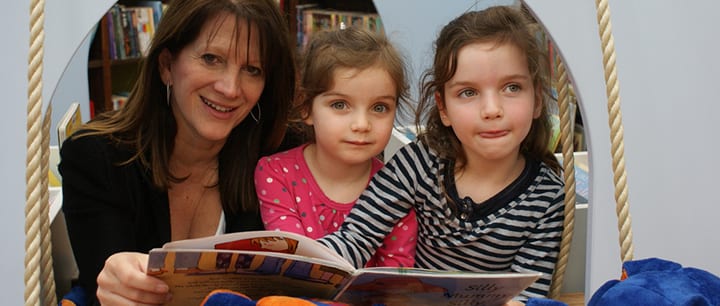How important is reading aloud to children? Here, Chicago tutor Galen B. reviews the benefits and some helpful tips…
Whether your child is not yet talking or is working on chapter books, reading aloud with her is a valuable exercise. According to the U.S. Department of Education, “reading aloud to children is the single most important activity for building knowledge and eventual success.”1 It introduces vocabulary and word-sound association, which builds the foundation for literacy. It also creates excitement about books, which is essential for developing an avid reader. Finally, reading aloud builds an understanding of how books work and models fluency, which are essential for reading comprehension. Follow these tips to get the most out of your reading experience.
1. Build excitement about books. A child who is excited about books is more likely to choose to read on her own. Ask your child about his favorite page or character, and why he chose it. Be willing to read a beloved book over and over. Find other books by that author or illustrator, and learn about him or her online. Visit your local library together, and build your own library at home—just make sure that it’s low enough for your child to reach!
2. Expand vocabulary. The more words a child hears, the more words she will know. Choose books that have challenging vocabulary to introduce her to new words in context, and read books multiple times to reinforce the vocabulary. Move beyond the words provided by talking with your child about what’s happening in the pictures or how the characters are feeling, and guessing what will happen next. This will help your child learn vocabulary for emotions, describe what she sees, and make inferences.
3. Focus on the text. Familiarizing your child with printed text is important for beginning literacy. Alphabet books are a good place to start, but there’s no need to stop there. Notice the letters in your child’s name, or pick a letter of the day and find words that start with or include it. Books with repetition are especially helpful for early learners. Point to each word as you read, and notice repeating patterns.
4. Learn letter sounds. A child doesn’t have to know her letters before she starts playing with sounds. Point to objects in the illustrations that start with a certain sound (“I see something that starts with /b/… it’s a bunny! Do you see something that starts with /s/?”). Read books with alliteration, and emphasize the beginning sound in each word. Read rhyming books, and let your child finish the line (“Miss Mary Mack, Mack, Mack, all dressed in _____.”) Help your child connect letters and sounds by picking one word for each letter and referencing it often (D for dog, T for truck, G for gorilla, etc.).
5. Talk about the plot. Make guesses about what will happen next, talk about the book’s problem and solution, and have your child “read” the book to you using the pictures. Along with building vocabulary and interest, these exercises will help your child understand how books work and help him when he writes his own stories.
6. Build reading fluency. Even if your child is putting words together, she may not read fluently. Model fluent reading by reading aloud, and then let your child read a familiar book back to you. By listening and repeating what she hears, your child will learn how fluent reading sounds and become a more confident reader. Reading fluency helps build comprehension, which allows your child to see past the printed word and into the story.
It’s never too early or too late to read aloud with your child. The more words an infant hears, the wider his vocabulary will be in preschool, and the earlier he engages with books, the more he will see them as friends later. The benefits of reading aloud to children don’t stop when they can read of their own, either. Reading together is fun and shows that you appreciate books. Keep these reading tips in mind and make reading aloud part of your everyday routine, and your child will be reading before you know it!
1. Richard C. Anderson, Elfrieda H. Hiebert, Judith A. Scott, and Ian A. G. Wilkinson, Becoming a Nation of Readers: The Report of the Commission on Reading, U. S. Department of Education (Champaign-Urbana, IL: Center for the Study of Reading, 1985), p. 23.
 Galen B. tutors in a variety of subjects in Chicago, IL, as well as online. She has four years of experience teaching elementary Spanish, two years of experience teaching ESL, and one year of experience teaching reading and writing to K-12 students. Learn more about Galen here!
Galen B. tutors in a variety of subjects in Chicago, IL, as well as online. She has four years of experience teaching elementary Spanish, two years of experience teaching ESL, and one year of experience teaching reading and writing to K-12 students. Learn more about Galen here!
 Photo by lynnefeatherstone
Photo by lynnefeatherstone
Suzy S.

